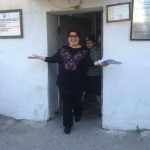The numbers alone are appalling: nearly 100 political prisoners. Dozens of attacks on journalists, stretching back nearly 15 years.
Spurred by the high-profile arrest of investigative journalist Khadija Ismayilova last December, her colleagues in Azerbaijan and the United States began to wonder about the people behind those numbers.
Who were they? What, exactly, had happened to them?
Over a period of months, two groups working in two very different countries pieced together a mosaic of data to show how the government of Azerbaijan has systematically moved to curtail the rights of its own citizens.
The Khadija Project is proud of the results, released today: a comprehensive and interactive timeline showing key steps the government took to crush journalistic freedoms, from 1999 to the present. It is paired with an interactive archive of Azerbaijan’s political prisoners, compiled by www.jumpstart.ge and www.meydan.tv.
The two databases overlap, as the government of Azerbaijan increasingly moves to silence independent journalists with prison terms.
Ismayilova anticipated her arrest and called on journalists to continue her investigative work. Though barred from leaving her country to speak as a witness before the U.S. Helsinki Commission in November 2014, Ismayilova submitted written testimony detailing the Azerbaijani government’s efforts to silence independent journalists whose work has exposed the corrupt practices of the ruling elite.
That testimony inspired the timeline.
Deborah Nelson, a Pulitzer Prize-winning journalist and one of The Khadija Project’s editors, asked Amanda Erickson, an editor at The Washington Post, and journalist Courtney Mabeus to team up to compile a list of assaults—legal and physical—against the country’s journalists.
Mabeus, who was one of Nelson’s students at the University of Maryland’s Philip Merrill College of Journalism, had already been researching Azerbaijan for another project. Erickson reported from Azerbaijan from 2010-11 and again in 2014. While there, she worked closely with several Azerbaijani journalists, including Ismayilova.
“I was constantly impressed with their bravery and determination in the face of severe government oppression,” Erickson said of the journalists she met.
Building the timeline laid bare a pattern of violations against independent press in Azerbaijan. The reporters found dozens of cases in which journalists were threatened, beaten, harassed or even killed for their work going back as far as 1999. When journalists themselves weren’t the direct targets, their news organizations often were, with laws intending to muzzle news media through various tactics.
Many entries were documented through sources including the Committee to Protect Journalists and Amnesty International, among others. Reporters also relied on conversations with Azerbaijani journalists, many of which have been forced in recent years to take refuge outside their country, as well as journalist and political analyst Arzu Geybullayeva’s timeline of 2014 offenses against the country’s civil society.
It is unknown how many other Azerbaijani journalists have been threatened, beaten or harassed without reporting the crimes, or who have self-censored their work for fear of retribution. This timeline likely only scratches the surface.
Shining a Light on Injustice
In a similar vein, the goal of https://www.prisoners.watch/en is to illuminate actions taken by the government of Azerbaijan to limit freedom of speech, association, and belief. These are people who have been jailed because they demanded those rights.
They are or have been in an Azerbaijani prison because they have uncovered corruption, exposed the truth or spoken out in a manner the government doesn’t like. The site includes trends and summary statistics about these prisoners of conscience.
Work on the list of prisoners began more than a year ago and came to a halt when the man working on it was jailed himself. Prior to her own detention, Ismayilova published the list online and distributed it worldwide. Now her colleagues are keeping the list up to date and circulating it as widely as possible.

As Azerbaijani civil society remains under attack, this is a work in progress. The data and features found here are constantly being updated and challenged; the information was compiled by www.jumpstart.ge and www.meydan.tv. For more information, contact the project at [email protected].







